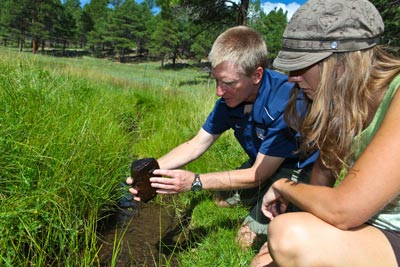With more than 90 percent of northern Arizona’s springs degraded or disappearing, Northern Arizona University hydrologists will be using new dollars to focus on new life in high elevation wetlands.
The Nina Mason Pulliam Charitable Trust is providing $146,000 to fund the two-year collaborative project in partnership with NAU, the Grand Canyon Trust’s Spring Stewards and the Grand Canyon Wildlands Council. Some 200 sites on the Coconino and Kaibab National Forests will be studied in an effort to identify and restore high priority springs. The gift was presented to the NAU Foundation on Nov. 17.
“More than 1,000 springs and spring-fed wetlands support rich plant and animal life in northern Arizona, including rare species such as the northern leopard frog,” said hydrogeology professor Abe Springer of NAU’s School of Earth Sciences and Environmental Sustainability. “Unfortunately almost all of them have been declared ‘at risk’ by the Arizona Water Institute.”
Scientists say changes to the forest since pioneers arrived have caused the degradation.
Ecological Restoration Institute hydrologist Sharon Masek Lopez said, “Many springs were plumbed decades ago to deliver drinking water to livestock. But this infrastructure is often dilapidated and can neither effectively provide water to livestock nor water for the riparian or wet meadow environments that springs would naturally support.”
In addition, millions of trees in Arizona’s forests are absorbing water and drying out meadows that historically were spongy, muddy and wet.
“Trees use a greater amount of soil moisture than grasses and may be keeping springs from flowing,” Springer said.
One of the project’s tasks will be to evaluate existing springs’ water rights to determine which springs are no longer being used for people or livestock and can be regained for aquatic habitat.
Because springs are hotbeds for biodiversity, prioritizing them is a significant component of large forest health projects such as the Four Forest Restoration Initiative currently in the planning stages for 2.4 million acres of Arizona’s ponderosa pine forest.
Through interviews, questionnaires and site visits, hydrologists expect to identify at least 50 spring sites for restorative action.



